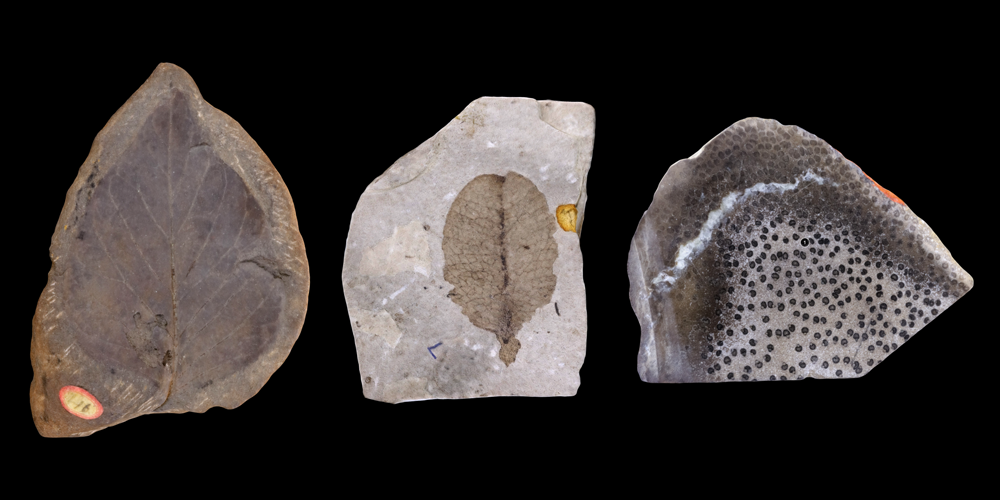This virtual collection was last curated by Elizabeth Hermsen and Jonathan Hendricks on August 22, 2019. Each model is licensed under a Creative Commons Attribution-ShareAlike 4.0 International License. Unless otherwise indicated, each model was created by Emily Hauf using specimens at the Paleontological Research Institution, Ithaca, New York.
You can learn more about flowering plants on the Digital Encyclopedia of Ancient Life.
Clade Monocots
Order Arecales
Family Arecaceae (palm family)
Petrified fossil specimen of the palm Palmoxylon cheyennense from the Cretaceous Pierre Formation near the Black Hills, South Dakota. Palm trees are monocots and do not produce true wood. Instead, the trunk of a palm has many vascular bundles (the vascular bundle caps look like black dots on the above specimen) in a matrix of ground tissue. Specimen is from the Cornell University Paleobotanical Collection (CUPC), Ithaca, New York (#1656). Length of rock is approximately 5.5 cm.
Clade Eudicots
Order Saxifragales
Family Cercidiphyllaceae (katsura family)
Fossil angiosperm Cercidiphyllum genesevianam and other associated plant fossils from the Paleocene of Alberta, Canada. Living Cercidiphyllum, or katsura, is native to Japan, but may be seen in cultivation elsewhere. Associated with the Cercidiphyllum leaf are conifer branchlets. Specimen is from the Cornell Unversity Paleobotanical Collection (CUPC), Ithaca, New York (#2082). Length of specimen is approximately 13.5 cm.
Subclade Rosids-Malvids
Order Sapindales
Family Sapindaceae (soapberry family)
Fossil fruit of the flowering plant Koelreuteria allenii from the late Eocene Florissant Flora of Florissant, Colorado. The fruits of Koelreuteria are inflated and somewhat leaflike in appearance. This specimen shows one segment of an inflated fruit. Koelreuteria (Sapindaceae, soapberry family), or golden raintree, is today native to Asia, although it may be seen in cultivation elsewhere. Specimen is from the Cornell University Paleobotanical Collection (CUPC), Ithaca, New York (#1584-5). Length of leaf is approximately 4 cm.
Unclassified angiosperm leaves
Fossil angiosperm leaf from the Cretaceous Dakota Sandstone of south central Minnesota. Specimen is from the Cornell University Paleobotanical Collection (CUPC), Ithaca, New York (#2076.10). Length of specimen is approximately 12.5 cm.
Fossil plant leaf with associated epiphyllous fungi; locality information not available. Specimen is from the Cornell University Paleobotanical Collection (CUPC), Ithaca, New York (#31B). Length of leaf is approximately 5 cm.
Fossil plant leaf that purportedly shows evidence of epiphyllous fungi; locality information not available. Specimen is from the Cornell University Paleobotanical Collection (CUPC), Ithaca, New York. Length of leaf is approximately 7.5 cm.
Specimens from the Eocene of Tennessee, U.S.A.
The specimens below all come from the Eocene of Tennessee, southeastern U.S.A.; while they were originally described as coming from the Wilcox Group, they are probably from the middle Eocene of the overlying Claiborne Group (see here). The Wilcox flora was originally described by E.W. Berry in several publications from the early twentieth century (Berry 1916, 1922, 1930). While additional work has been done on these floras in more recent years, most of it has been on reproductive structures. Thus, the treatment of the leaves is somewhat dated, and interpretations of the affinities of the material at the genus and family levels should be considered provisional. Nevertheless, most of the leaves illustrated below have characteristics that link them to either Magnoliids or eudicots.
Fossil angiosperm leaf from the Eocene Wilcox Formation of Tennessee. Specimen is from the Cornell University Paleobotanical Collection (CUPC), Ithaca, New York (#1669). Length of specimen is approximately 9 cm.
Fossil angiosperm leaves from the Eocene Wilcox Formation of Tennessee. Specimen is from the Cornell University Paleobotanical Collection (CUPC), Ithaca, New York (#1669). Length of specimen is approximately 18 cm.
Fossil angiosperm leaf from the Eocene Wilcox Formation of Tennessee. Specimen is from the Cornell University Paleobotanical Collection (CUPC), Ithaca, New York (#1669). Length of specimen is approximately 8.5 cm.
Fossil angiosperm leaves from the Eocene Wilcox Formation of Tennessee. Specimen is from the Cornell University Paleobotanical Collection (CUPC), Ithaca, New York (#1669). Length of specimen is approximately 15 cm.
Fossil angiosperm leaves from the Eocene Wilcox Formation of Tennessee. Specimen is from the Cornell University Paleobotanical Collection (CUPC), Ithaca, New York (#1669). Length of specimen is approximately 15 cm.
Selected references & further reading
Note: Free full text is made available by the publisher for items marked with a green star.
* Berry, E.W. 1916. The lower Eocene floras of Southeastern North America. United States Geological Survey Professional Paper 91: 1-481. https://doi.org/10.3133/pp91
* Berry, E.W. 1922. Additions to the flora of the Wilcox Group. United States Geological Survey Professional Paper 131-A: 1-21. https://doi.org/10.3133/pp131A
* Berry, E.W. 1930. Revision of the lower Eocene Wilcox flora of the southeastern states. United States Geological Survey Professional Paper 156: 1-196. https://doi.org/10.3133/pp156
* Wang, H., J. Blanchard, and D.L. Dilcher. 2013. Fruits, seeds, and flowers from the Warman clay pit (middle Eocene Claiborne Group), western Tennessee, USA. Palaeontologia Electronica 16(3): article 13A, 73 pgs. https://palaeo-electronica.org/content/2013/545-eocene-plants-from-tennessee



